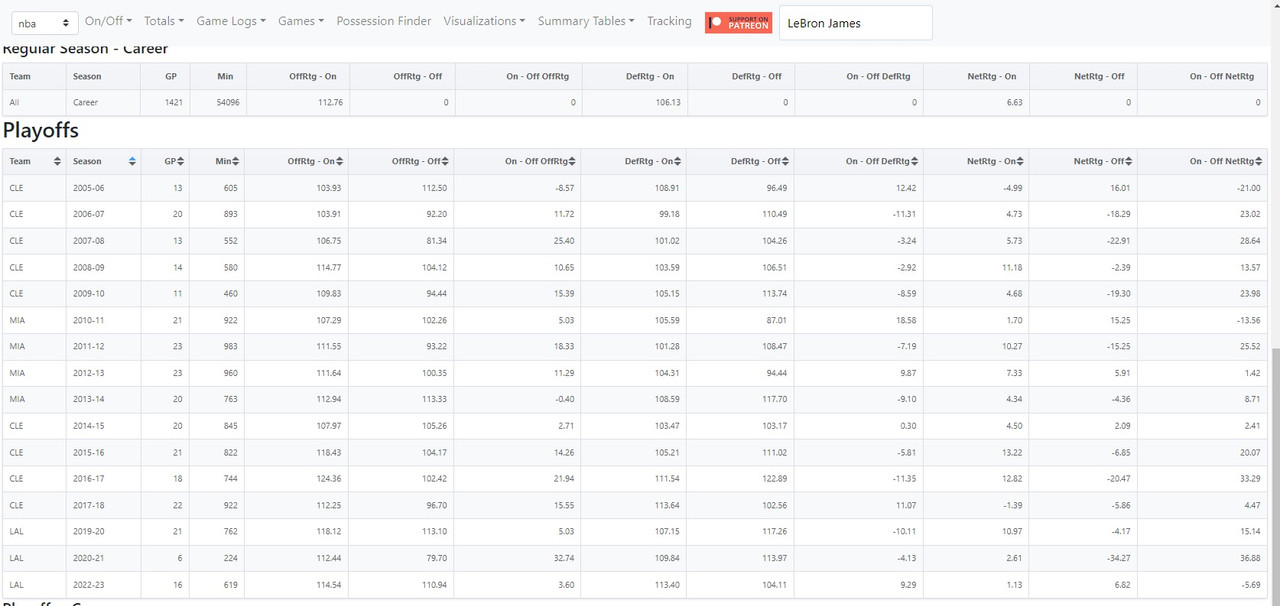OhayoKD wrote:Yeah, It looks that way because you are doing a different calculation than what is on the basketball-reference estimates. I do not know whether you are deliberately lying or you do not understand basic math principles as well as you claim, but for the thread’s benefit, you should detail exactly what you would do to calculate Lebron’s numbers with the same process you used to calculate Jordan’s if you had no access to those on/off estimates.
Perhaps cut down on the rudeness. You don’t need to make personal attacks to discuss basketball. I’ll address the rest of this below, but just wanted to call this out specifically here. There’s just no need for this behavior.
To be clear. What Jake is doing is in essence calculating Jordan’s per 48 average (without posting it because that would reflect poorly on Jordan) and then multiplying it by 100/“Average BBRef Bulls Postseason Pace in applicable years” and then comparing it to Lebron's BBref on/off as opposed to undergoing the same process with Lebron.
Umm, you make this post after I literally posted a per-48-minute average in this very thread, in the very post that you’re responding to (and, spoiler alert, Jordan still looks substantially better). So this is a pretty wild accusation from you.
Anyways, the reason I’m not “undergoing the same process with LeBron” is that we have better data for LeBron so there’s no need to. When we have actual per-100-possession data (which we do for LeBron), then we should
obviously use that rather than trying to derive per-100-possession data using per-48-minute data. For Jordan, we don’t have per-100-possession data, so our best option to get that data is to derive it from per-48-minute data using the team’s pace. I’ve been quite upfront with the fact that there’s potential error in that (for instance, if the pace on and off the court was different), but it’s obviously the best method we have for Jordan. It would obviously be dumb to use the same method for LeBron, because we actually have the real error-free numbers.
Of course, even if we *did* look at per-48-minute on-off, saying that LeBron “matches” Jordan is a bit odd. In the data we actually have, Jordan’s per-48-minute playoff on-off is, by my calculation, about +15.7, while LeBron’s per-48-minute on-off even in that specific optimal timespan you identify is, according to you, +13.8. So yeah, LeBron doesn’t match Jordan.
Uh
[note from lessthanjake: cut out the spoiler of homecourtloss since it was breaking the website]
Adding 4 games should not be taking us from sub-14 up to 16.
I don’t have any idea what method or data homecourtloss used to calculate those numbers. The method I used to calculate the per-100-possessions data is
extremely transparent, with there being a very long post explaining every bit of my methodology. And I can tell you that what I did to calculate a per-48-minute value for Jordan in my earlier post in this thread was just to take the eyeballed values in the Thinking Basketball video (see the other thread detailing exactly what those eyeballed values were) and the known values from the Squared 1985 playoff data and then calculated “on” and “off” values by doing a weighted average based on the number of “on” minutes and the number of “off” minutes. Pretty simple stuff. And it looks great for Jordan.
Yes you know, it is a massive negative but not exactly just how massive, so better throw it out entirely and pretend it is not there.

How about this? Use the
nicest derived result you can. There are a few different approaches, but even the most mild is still an applicable drain.
I don’t think you quite understand the situation with 1995. There is no “nicest derived result.” There’s only one derived result, because there’s only one three-year chart in the Thinking Basketball video that includes 1995. And we know from trying other derivations that using one three-year chart is prone to a huge amount of inaccuracy, and this inaccuracy is doubled because we’re trying to derive two values (both “on” and “off”). It’s just not data that should really be thrown into an average, since it’s just incredibly rough. [That said, as you well know, I did make an attempt to do so in a post in the other thread—which makes your accusation here that I am “pretend[ing] it is not there” really odd—and Jordan’s playoff on-off still looked fantastic, at about +15 per 100 possessions.]
Ultimately, I think what we can say is that 1995 would drag down the average, by some unspecified amount. What we can also say is that the optimal timespans you’re using for LeBron involve cutting out playoffs that drag down his average too. The bottom line is that you’ve identified an optimal time period for LeBron that includes just under 90% of his playoff games, and we have decent data on just over 90% of Jordan’s playoff games. And when we compare those, Jordan’s playoff on-off is clearly superior.








